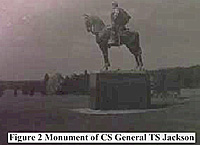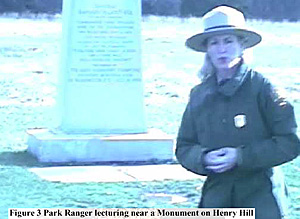 Today is 25 November, and Michael and I decided to do a short tour of the First Battle of
Bull Run. This is an ideal battle to cover in about two hours, as much of it is located
around the visitors’ centre a top Henry Hill. The temperature was cooler (about 45 F)
than yesterday, but lots of clear blue sky again. A brisk wind added to the chillness in the
air making it uncomfortable to stand and listen to the park ranger, who was our guide.
Today is 25 November, and Michael and I decided to do a short tour of the First Battle of
Bull Run. This is an ideal battle to cover in about two hours, as much of it is located
around the visitors’ centre a top Henry Hill. The temperature was cooler (about 45 F)
than yesterday, but lots of clear blue sky again. A brisk wind added to the chillness in the
air making it uncomfortable to stand and listen to the park ranger, who was our guide.
We had previously visited the park separately in the past, so we agreed to focus this visit on the first battle. Our arrival was timely as the ranger at the front desk informed us that a guided tour of the first battle was about to begin. We had just enough time to look around the museum and then join the tour.
The ranger giving the presentation gathered us behind the visitors’ centre where we were able to see the Henry House (where Judith Hill lived and was killed by US artillery fire during the battle, the only civilian fatality) and guns marking the position of the gun batteries of US Captains J Rickett and C Griffin (both were captured by CS troops during the course of the conflict). From here we walked over to the monument of CS General TJ “Stonewall” Jackson, which dominates Henry Hill and acts as a focal point from which to view most of the battlefield for First Manassas.
 Here the ranger directed our attention to the area of the stone bridge on the Warrenton
Turnpike, where the CS troops first became aware of the US movements to cross the
Bull’s Run via Sudley Ford to the north and west of the stone bridge. Next our attention
was directed Matthew’s Hill (north of Henry Hill), which concealed Sudley Ford, Sudley
Springs Ford and Sudley Church – all marking the northern boundary of the battlefield.
Here CS Colonel NG Evans engaged the US vanguard and delayed its advance until
additional US formations arrived to threaten the CS flanks.
Here the ranger directed our attention to the area of the stone bridge on the Warrenton
Turnpike, where the CS troops first became aware of the US movements to cross the
Bull’s Run via Sudley Ford to the north and west of the stone bridge. Next our attention
was directed Matthew’s Hill (north of Henry Hill), which concealed Sudley Ford, Sudley
Springs Ford and Sudley Church – all marking the northern boundary of the battlefield.
Here CS Colonel NG Evans engaged the US vanguard and delayed its advance until
additional US formations arrived to threaten the CS flanks.
We could easily see Matthew’s Hill and the Stone House (which became a field hospital during the battle), thus could visualise the flight of the CS forces up to Henry Hill, where CS General TJ Jackson had his brigade positioned. It was here that the CS forces rallied in the cover of the woods and reverse slope. This ground was where the legend of “Stonewall” Jackson was born, although it is unclear as to whether or not he was actually described, along with his men, as “standing like a stone wall”. Nonetheless, his statue does give a very commanding view of the first battlefield.
The third and final stop was near the stone marker (see Figure 3) close to where US Captain Griffin placed two of his guns in an endeavour to flank the CS guns along the edge of the reverse slope of Henry Hill, where the main CS defensive line was positioned. These were the targets of a CS charge, which captured the two guns and was the first CS success of the battle. The ranger mentioned that the guns were lost partially because of the confusion about the identity of the CS soldiers, who were mistaken as US infantry sent to guard the flank of the two cannons. This is a good example of the problems incurred because of the similarities of uniforms used by both armies. Many such mistaken identifications (including the shooting of TS Jackson at Chancellorsville) occurred during the war.
The ranger pointed out Chinn Ridge where CS reinforcements from Manassas Junction successfully flanked the US army and forced the US troops to retreat. This action was a typical ACW tactic, getting onto the flank of the opposing side, and then sweeping the field of the enemy. This was frequently attempted, but was often unsuccessful because the terrain and flora masked the real flank. First Manassas and Chancellorsville were good examples of successful flank attacks
This concluded the approximately 45-minute presentation of the battle and we quickly sought shelter in the visitors centre to warm up.
Back to Sabretache # 6 Table of Contents
Back to Sabretache List of Issues
Back to MagWeb Master Magazine List
© Copyright 2003 by Terry Gore
This article appears in MagWeb.com (Magazine Web) on the Internet World Wide Web. Other articles from military history and related magazines are available at http://www.magweb.com